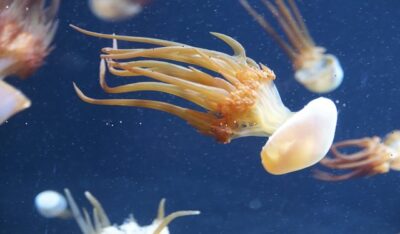Jellyfish for human consumption
Jellyfish and fishing diversification
The sea depletion, concerns about the future of small-scale fishers, force us to reflect on our food consumption models and above all to value products and diversified production.
Fishing, processing, marketing and consumption of jellyfish will be possible to start a new supply chain. Small-scale fishers would have the possibility of using unconventional marine species, such as jellyfish, which are often the object of accidental or by-catch, as a new source of livelihood.
Can You Eat Jellyfish?
Jellyfish are bell-shaped marine animals that are found in oceans all over the world.
Large and often colourful, they’re commonly known for their gelatinous bodies and long tentacles, which contain specialized stinging cells that can shoot out rapidly, injecting venom into predators and prey.
While some jellyfish species are toxic to humans, others are safe to eat.
In fact, jellyfish is commonly consumed in South-eastern Asia, as it’s believed to offer several health benefits.
Eating jellyfish safely
Before eating jellyfish, it’s important to be aware of how to safely consume it.
There are at least 11 species of jellyfish that have been identified as edible for human consumption.
As jellyfish can spoil quickly at room temperature, it’s important to clean and process it soon after being caught.
Traditionally, jellyfish are preserved by using an alum-salt mixture to dehydrate the meat. Alum is a brining component that acts as an antiseptic, reducing the pH while maintaining a firm texture.
How it’s used
Soon after being caught, jellyfish is cleaned and processed, usually by dehydrating it in a brining solution.
Before consumption, it’s often recommended to desalt jellyfish and rehydrated it by soaking it in water overnight to improve texture and reduce the salty taste.
Despite its name, prepared jellyfish has a surprisingly crunchy texture. However, depending on how it’s prepared, it can also be slightly chewy.
It has a delicate taste that tends to take on the flavors of whatever it’s cooked with. Still, if not desalted, it can be quite salty.
You can eat jellyfish in many ways, including shredded or sliced thinly and tossed with sugar, soy sauce, oil, and vinegar for a salad. It can also be cut into noodles, boiled, and served mixed with vegetables or meat.

High in several nutrients
Several species of jellyfish are safe to eat. While they may differ in nutritional content, they’ve generally been shown to be low in calories while still serving as a good source of protein, antioxidants, and several important minerals.
One cup (58 grams) of dried jellyfish provides approximately:
Calories: 21
Protein: 3 grams
Fat: 1 gram
Selenium: 45% of the Daily Value (DV)
Choline: 10% of the DV
Iron: 7% of the DV
It also contains small amounts of calcium, magnesium, and phosphorus.
While low in fat, studies have shown that about half of the fat in jellyfish comes from polyunsaturated fatty acids (PUFAs), including both omega-3 and omega-6 fatty acids, which are essential in the diet.
PUFAs, and omega-3 fatty acids in particular, have been associated with a reduced risk of heart disease, especially when eaten in place of saturated fat.
Finally, research has found that several species of edible jellyfish contain high levels of polyphenols, which are naturally occurring compounds that have been shown to have potent antioxidant effects.
Regularly consuming polyphenol-rich foods is thought to promote brain function and protect against several chronic conditions, including heart disease, type 2 diabetes, and cancer.
Potential health risks
Only a few species of jellyfish have been determined safe for human consumption.
That said, while safe for most, some people have been diagnosed with allergies to the animal after experiencing an anaphylactic reaction after eating cooked jellyfish.
Additionally, proper cleaning and processing are important for reducing the risk of foodborne illness from bacteria or other potentially hazardous pathogens.
There’s also concern that the method of preserving jellyfish could result in exposure to high levels of aluminum.
One traditional way of processing jellyfish employs a brining solution containing alum.
Alum is a chemical compound, also known as potassium aluminium sulfate, that’s sometimes used as an additive for preserving foods.
While the Food and Drug Administration (FDA) has certified it as a generally recognized as safe (GRAS) substance, there are concerns regarding the amount of aluminum retained in jellyfish products as a result of using alum.
The bottom line
Certain species of jellyfish are not only safe to eat but also a good source of several nutrients, including protein, antioxidants, and minerals like selenium and choline.
The collagen found in jellyfish may also contribute to health benefits like reduced blood pressure. Still, research in humans is currently lacking.
While there are some concerns over the use of alum in the processing of jellyfish, occasional or moderate intake is unlikely to result in excessive exposure to dietary .
Overall, when purchased from a reputable retailer, jellyfish can be a low calorie yet nutritious way to add a uniquely crunchy texture to your dishes.
Reference
· Jellyfish Stings and Their Management: A Review – PMC (nih.gov)
· Identification of Safety and Quality Parameters for Preparation of Jellyfish Based Novel Food Products – PMC (nih.gov)
· The Bright Side of Gelatinous Blooms: Nutraceutical Value and Antioxidant Properties of Three Mediterranean Jellyfish (Scyphozoa) – PMC (nih.gov)
· Allergic shock caused by ingestion of cooked jellyfish: A case report – PubMed (nih.gov)
· Can You Eat Jellyfish? (healthline.com)
· Eating jellyfish: safety, chemical and sensory properties – PubMed (nih.gov)








